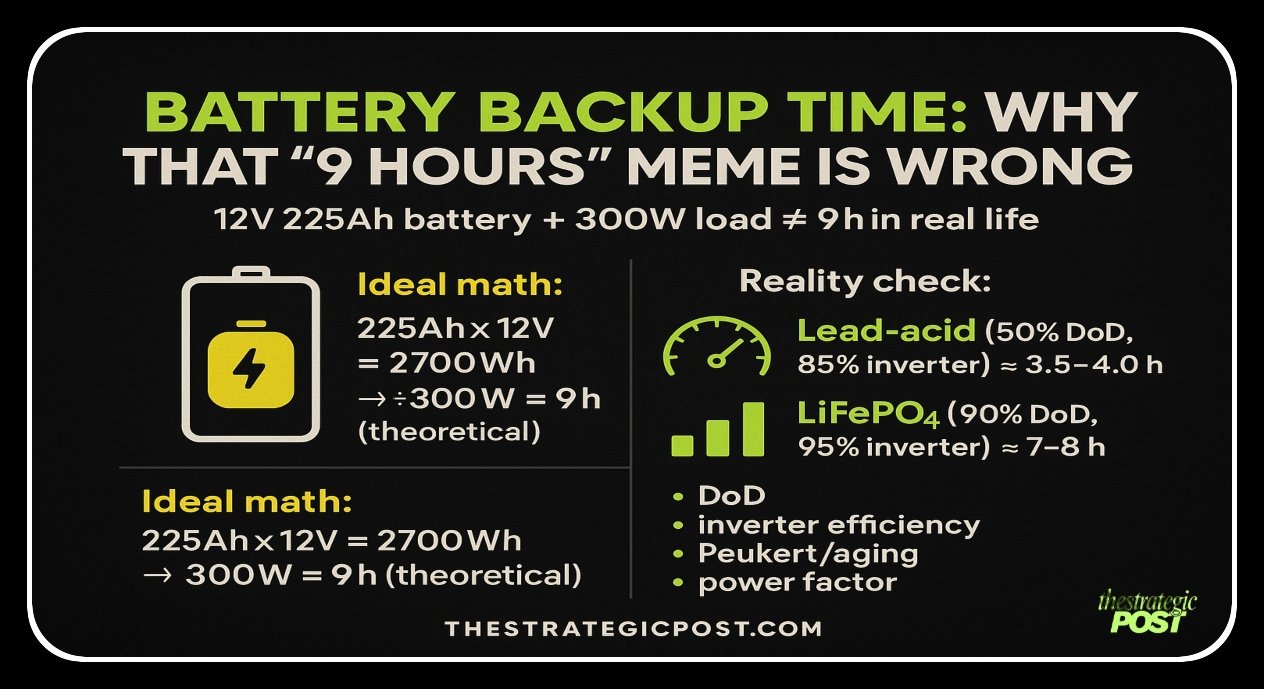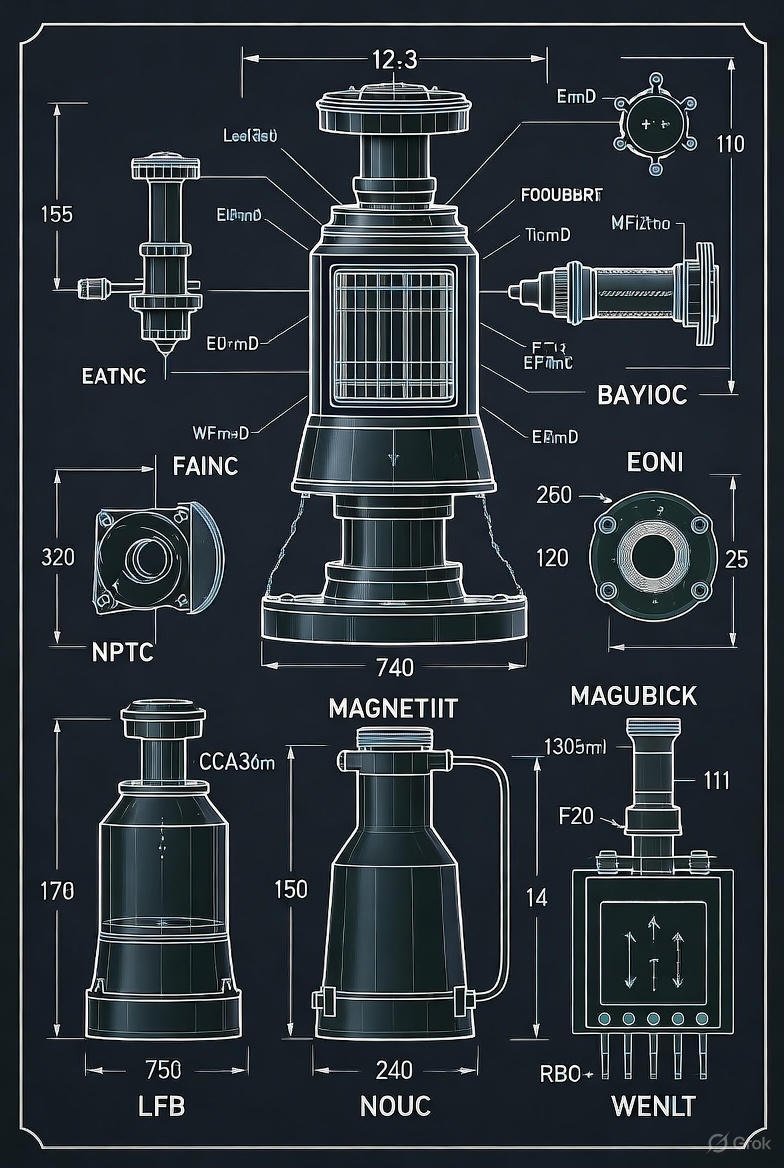Table of Contents
Battery Backup Time: Why That “9 Hours” Meme Is Wrong (and How to Calculate It Right) 🔋
Published: September 3, 2025

A viral graphic says a 12V, 225Ah battery can run a 300W load for 9 hours. Sounds awesome—until you factor in real-world stuff like inverter losses, depth of discharge, and Peukert effect. Here’s the clean, SEO-friendly guide you can trust.
TL;DR
- Textbook math (Ah × V ÷ Watts) gives 9 h—but that assumes 100% efficiency and draining the battery to zero.
- Realistic runtime depends on battery chemistry and inverter efficiency:
- Lead-acid (50% DoD, ~85% inverter): ~3.5–4.0 hours at 300W
- LiFePO₄/Lithium (90% DoD, ~95% inverter): ~7–8 hours at 300W
- To size properly: use lumens— kidding 😄—use Wh, DoD, and inverter efficiency.
The Easy Formula (Ideal World)
Energy (Wh) = Ah × V
Runtime (h) = Energy (Wh) ÷ Load (W)
For 12V, 225Ah:
- Energy = 225 × 12 = 2700 Wh (= 2.7 kWh)
- 300W load → 2700 ÷ 300 = 9.0 h ✅
But this ignores losses and battery life limits.
The Real-World Corrections (What the meme misses)
- Depth of Discharge (DoD)
- Lead-acid likes ~50% DoD to last years.
- Lithium (LiFePO₄) comfortably allows 80–90% DoD.
- Inverter Efficiency (η)
- Typical line-interactive inverters: ~85%.
- Good lithium setups can hit ~95%.
- Peukert & Aging (lead-acid)
- Higher currents reduce effective capacity; expect another 10–20% hit at ~25–30A draw.
- Old batteries deliver less than nameplate.
Step-by-Step Example (12V, 225Ah, 300W)
Nominal energy: 225Ah × 12V = 2700 Wh
A) Lead-acid, conservative sizing
- Usable energy = 2700 × DoD × η
- DoD = 0.50, η = 0.85
- Usable = 2700 × 0.50 × 0.85 = 1147.5 Wh
- Runtime = 1147.5 ÷ 300 = 3.825 h
- Allow a Peukert/aging margin (~0.85) → ~3.3 h to ~3.8 h realistic
B) Lithium (LiFePO₄), quality inverter
- DoD = 0.90, η = 0.95
- Usable = 2700 × 0.90 × 0.95 = 2308.5 Wh
- Runtime = 2308.5 ÷ 300 = 7.695 h → ~7–8 h realistic
Quick Reality Table (Same 12V, 225Ah, 300W)
| Setup | DoD | Inverter η | Usable Wh | Est. Runtime |
|---|---|---|---|---|
| Textbook (meme) | 100% | 100% | 2700 | 9.0 h |
| Lead-acid (good practice) | 50% | 85% | 1147.5 | ~3.5–4.0 h |
| Lithium (LiFePO₄) | 90% | 95% | 2308.5 | ~7–8 h |
Fans and some appliances have power factor < 1. Your inverter “sees” more VA than W. Size the inverter by VA; size runtime by real watts (what the appliance actually consumes).
Planning a Battery Bank (No Guesswork)
- Add your loads (true watts), then add 10–20% headroom.
- Pick chemistry (lead-acid vs lithium) → choose DoD.
- Select inverter → note efficiency at your load.
- Compute Wh needed: Runtime target (h) × Load (W) ÷ (DoD × η).
- Design voltage (12/24/48V) for lower current and happier cables.
- Parallel/series math:
- Series → higher V, same Ah (more Wh).
- Parallel → same V, higher Ah (more Wh).
Example: Want 6 hours at 300W on lead-acid (50% DoD, 85% η)?
- Required Wh = 6 × 300 ÷ (0.50 × 0.85)
- = 1800 ÷ 0.425 = 4235 Wh
- At 12V, Ah needed = 4235 ÷ 12 = 353 Ah (usable bank).
- Practically: go 24V to halve current and improve performance.
FAQs
Q: My lights are “10W” each—do I use 10W or more?
A: Use the real wattage from specs or a plug-in meter. Add 10–15% if you don’t know PF/driver losses.
Q: Can I drain lead-acid to 80% DoD for longer backup?
A: You can, but lifespan drops sharply. For daily cycling, 50% DoD is the sweet spot.
Q: Why does voltage choice matter?
A: Higher bank voltage (24/48V) means lower current, cooler cables, smaller losses, and happier inverters.
Bottom Line
The meme’s 9 hours is theoretical. In the real world, expect ~3.5–4 hours on lead-acid and ~7–8 hours on lithium for a 12V 225Ah bank at 300W. Do the math with DoD and efficiency, and your backup won’t disappoint.
Want a one-click calculator and wiring diagrams for 12V/24V/48V? Say the word—I’ll drop a single-block HTML tool you can paste into TheStrategicPost.







